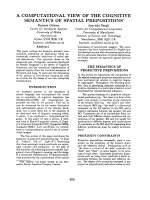- Trang chủ >>
- Khoa Học Tự Nhiên >>
- Vật lý
prescriptions for the mind a critical view of contemporary psychiatry jun 2008
Bạn đang xem bản rút gọn của tài liệu. Xem và tải ngay bản đầy đủ của tài liệu tại đây (775.93 KB, 264 trang )
Prescriptions for the Mind
This page intentionally left blank
Prescriptions
for the Mind
A Critical View of
Contemporary Psychiatry
JOEL PARIS, MD
1
2008
1
Oxford University Press, Inc., publishes works that further
Oxford University’s objective of excellence
in research, scholarship, and education.
Oxford New York
Auckland Cape Town Dar es Salaam Hong Kong Karachi
Kuala Lumpur Madrid Melbourne Mexico City Nairobi
New Delhi Shanghai Taipei Toronto
With offices in
Argentina Austria Brazil Chile Czech Republic France Greece
Guatemala Hungary Italy Japan Poland Portugal Singapore
South Korea Switzerland Thailand Turkey Ukraine Vietnam
Copyright # 2008 by Oxford University Press, Inc.
Published by Oxford University Press, Inc.
198 Madison Avenue, New York, New York 10016
www.oup.com
Oxford is a registered trademark of Oxford University Press
All rights reserved. No part of this publication may be reproduced,
stored in a retrieval system, or transmitted, in any form or by any means,
electronic, mechanical, photocopying, recording, or otherwise,
without the prior permission of Oxford University Press.
Library of Congress Cataloging-in-Publication Data
Paris, Joel, 1940–
Prescriptions for the mind : a critical view of contemporary psychiatry / Joel Paris.
p. ; cm.
Includes bibliographical references and index.
ISBN 978-0-19-531383-3
1. Psychiatry—Philosophy. 2. Psychotherapy—Methodology.
[DNLM: 1. Psychiatry—methods. 2. Mental Disorders. WM 100 P231p 2008] I. Title.
RC437.5.P37 2008
616.89001—dc22 2008006681
135798642
Printed in the United States of Amer ica
on acid-free paper
This book is dedicated to Leon Eisenberg.
This page intentionally left blank
Contents
Acknowledgments ix
Introduction xi
part i—MODELS
1. Neuroscience and Psychiatry 3
2. Psychotherapy and Psych iatry 21
part ii—DIAGNOSIS
3. Diagnosis in Psychiatry 37
4. The Boundaries of Mental Disorde rs 55
5. Mood and Mental Illness 65
6. Psychiatry’s Problem Children 83
part iii—TREATMENT
7. Evidence-Based Psychiatry 101
8. Psychiatric Drugs: Miracles and Limitations 111
vii
9. Talk Therapies: The Need for a Unified Method 133
10. Psychiatry in Practice 149
part iv—OUTLOOK
11. Training Psychiatrists 171
12. Psychiatry and Society 183
13. The Future of Psychiatry 197
Endnotes 209
References 213
Index 235
viii Contents
Acknowledgments
I
would like to thank Roz Paris and Ned Shorter, who read earlier ver-
sions of this book and made many useful suggestions for improvement,
and also Leon Eisenberg, Maurice Dongier, Richard U’ren, and Hallie
Zweig-Frank, who offered helpful comments on early drafts of several
chapters.
A special thanks to my editor at Oxford, Marion Osmun, who be-
lieved in this book and took the time to work with me on its shape and
contents.
ix
This page intentionally left blank
Introduction
Two Visions of Psychiatry
Psychiatrists are experts on the mind and its maladies. But no one is quite
sure anymore what it is they do.
It is not surprising that the public has difficulty understanding
the field. Psychiatrists themselves are confused about how they should
practice.
The discipline remains divided between two visions, and there
is a continuing struggle within psychiatry about its future role.
Should psychiatrists be more like neurologists—examining patients,
making diagnoses, and prescribing drugs? Or should they be more like
psychologists—prob ing the inner workings of the mind and providing
expert psychotherapy?
These contrasting visions are not new. In a book published fifty years
ago, a sociologist, August Hollingshead, and a psychiatrist, Fritz Redlich,
described two types of psychiatrists (Hollingshead and Redlich, 1958).
One wore white coats and treated patients in hospitals; the other wore
sports jackets and treated patients with psychotherapy in offices. Twenty
xi
years later, when I studied psychiatry, my teachers could easily be sep-
arated into these two camps.
A seminal article in the BritishJournalofPsychiatryin 1986 by the
Harvard psychiatrist Leon Eisenberg, entitled ‘‘Mindlessness and Brain-
lessness in Psychiatry,’’ followed by other publications, critically examined
both approaches (Eisenberg, 1986, 1995, 2000). Eisenberg labeled the
psychiatry of the past—one that relied on the speculative theory of psy-
choanalysis—‘‘brainless’’ because it did not give any serious attention to
neuroscience. He was equally critical of a psychiatry that simply saw
mental illness as disorders of the brain; a view he labeled ‘‘mindless.’’
1
In short, both visions are too narrow. Mental illness cannot be un-
derstood without taking both biology and psychology into account. In
that way, psychiatrists are unique. They are almost the only practitioners
who regularly treat patients with combinations of biological and psy-
chological interventions.
Unfortunately, the complexity of the real world runs counter to the
preference of the human mind for simplicity. Most people find it easier to
think that diseases have single causes. Yet direct and linear relationships
between risk factors and actual illness are very rare. One of the themes of
this book is that to carry out its mission, psychiatry must embrace
complexity.
The Public Image of Psychiatry
Every month, scientific findings in the field of psychiatry appear in
top journals and are summarized and discussed in leading newspapers
and magazines. Many educated people are familiar with the latest re-
search in the field. In recent years, the media have highlighted biological
findings in psychiatry, and one gets the impression that the neurosci-
ences are about to so lve the mystery of mental illness. Psychiatrists also
seem to believe this. They have become much more biological in their
thinking and their practice, and their encounters with patients have
come to focus more and more on drug prescriptions.
As psychiatry has changed, so has its public image. Even today, some
people see psychiatrists as psychotherapists and are unsure how they
differ from psychologists. To counter this confusion, psychiatry has de-
fined itself firmly as a medical specialty. As we will see, this choice of
identity has had vast implications.
xii Introduction
The Couch and the Prescription Pad
For many years the most familiar symbol of psychiatry was the analytic
couch. Readers of New Yorker cartoons can attest that the stereotype
remains alive and well. But few psychiatrists today are psychoanalysts,
and only some psychoanalysts are psyc hiatrists. Those who practice talk
therapies see patients in an armchair, face-to-face. Many psychiatrists,
however, never practice formal psychotherapy. Like other physicians,
their primary tool is a prescription pad.
As the biological model of mental illness triumphed, talk therapies
were marginalized. In a previous book, I examined the decline of psy-
choanalysis and its dramatic fall from grace within academic psychiatry
(Paris, 2005a). With psychoanalysis a fallen icon, what role was left for
talk therapies? Unfortunately, a healthy baby was thrown out with the
bathwater. As this book will show, psychotherapy has as strong a base in
scientific evidence as any drug on the market. Newer forms of treatment,
such as cognitive-behavioral therapy, have a solid base in science, but are
most often provided by psychologists.
The force driving psychiatry today is its wish to be accepted as a
medical specialty. To gain acceptance, psychiatry adopted a new para-
digm paralleling the worldview of internal medicine, in which practice is
based on systematic diagnosis, laboratory tests, and drug prescriptions.
This change was overdue and was in most ways positive. But since our
knowledge base remains sadly undeveloped, the idea that a new psy-
chiatry can be built entirely on neuroscience is a dangerous illusion. In
spite of all its advances, brain research has thus far taken only baby steps.
It will be many decades before the complexity of the brain is unraveled
and the true causes of mental disorders are known.
In reality, psychiatrists are treating conditions that they barely un-
derstand. Our diagnoses are, at best, rough and ready, and do not deserve
the status of categories in other specialties. We have no laboratory tests
that can reliably identify any mental disorder, and the measures we use
are entirely based on clinical observations. Although our drugs can be
powerful and effective (when used properly), we are over-prescribing
them and offering them to patients who do not need them .
This book will challenge the myth of the expert who cures mental
illnesses by adjusting and adding medications. Psychiatrists could help
more people by spending less time with prescription pads and more time
Introduction xiii
listening and talking to their patients. But this does not mean we should
return to the analytic couch. It means, at least in part, that psychiatrists
have to be interested in patients’ lives and understand how events in-
fluence symptoms. They also need to acknowledge what they know and
what they do not know so they can treat patients more intelligently and
more effectively.
The Best of Both Worlds
This book will focus on the cost of psychiatry’s shift in orientation. The
choice of a narrowly medical identity that focuses exclusively on bio-
logical research and treatments has led to an impoverished practice.
Biology is a necessary part of the theory and practice of psychiatry but
does not provide a complete explanation of disease or a comprehensive
guide to treatm ent. Psychiatrists diagnose patients from a manual and
convince themselves that they are describing illnesses as specific as
stroke or breast cancer. Even more seriously, some psychiatrists have
forgotten how to talk to people. Many prescribe medication and do lit-
tle else.
This critique should not in any way be seen as devaluing biological
research or biological treatments. The conditions psychiatrists treat af-
fect the brain. But this does not mean that the source of mental problems
always lies at the level of neurons. Our psychological and social envi-
ronment can make us anxious or depressed, leading in turn to changes in
brain function. A discipline devoted to mental illness cannot ignore the
mind.
The biological paradigm that dominates psyc hiatry today can be
understood as a reaction against the past, when theories were spun out of
thin air and patients were offered unscientific methods of treatment. But
this book is not intended in any way to be an attack on psychiatry itself.
We have had too much of that sort of thing. Starting with Thomas Szasz,
‘‘anti-psychiatrists’’ have refused to accept the biological basis of men-
tal illness, and some even seem to think that psychiatrists should stop
prescribing drugs (Breggin, 1994; Szasz, 1974). The very real benefits
of pharmacological treatment would be lost if w e were to adopt such
backward-looking and misguided ideas. Psychiatrists must res ist an
either/or attitude when it comes to the study and treatment of mental
illness.
xiv Introduction
Who This Book Is for and What It Is About
I have written this book for several audiences. Health professionals and
trainees, inside or outside psychiatry, will want to know where the field is
going and how much science is behind it. Moreover, since this book
emphasizes the importance of scientific practice, I will be quoting data to
support most of what I have to say. Of course, there are many contro-
versies in psychiatry, and I do not have enough space to go into all of
them in depth. And however much I am committed to evidence-based
psychiatry, there are many important issues about which we have very
limited data. But wherever I express a clinical opinion based on my own
experience, I will make that clear.
I also hope that nonprofessionals will find this book enlightening. In
an era of open information, psyc hiatric patients (and their families) need
to understand the concepts behind our specialty. The educated public,
which has long had a special interest in the field, needs to be updated on
the vast changes occurring in psychiatry.
In summary, this book aims to provide an overview of contemporary
psychiatry—how we got there, where we are now, and what is likely
to happen in the future. As an academic, a researcher, and a teacher,
I examine the discipline from the perspective of an insider. And as a
practitioner who has always been committed to a psychiatry rooted in
biology and psychology, I have written a book that aims to provide a
balanced point of view, taking into account the strengths and weaknesses
of both perspectives.
Introduction xv
This page intentionally left blank
part i
MODELS
This page intentionally left blank
1
Neuroscience and Psychiatry
A
lmost every day, one can read media reports on the latest develop-
ments in neuroscience. Scientific journals are packed with exciting
new findings. As a result, we have never known so much about the human
brain as we do now, and psychiatrists and their patients could eventually
be among the beneficiaries of this research. New research has, for example,
raised hope that the causes of mental illness will be explained by brain
abnormalities. It has also spurred investigations into genetics and specif-
ically prompted a search for genes that may be associated with mental
disorders. Meanwhile, a large body of research has examined the role of
neurotransmitters in these disorders. Part of what has made this extraor-
dinary brain science possible involves new imaging techniques that, by
producing dramatic pictures of the brain, seem to unlock its secrets. A
large body of research has examined how neurotransmitters are involved in
mental disorders. Even more exciting is the prospect that research in
neuroscience may lead to new and more effective methods of treatment.
The advances in neuroscience in recent years have, without doubt,
been scientifically impressive. But how do they affect medical practice?
Will the psychiatrist of tomorrow prescribe more powerful drugs guided
3
by gene profiles and brain scans? Will future psychiatrists become high-
tech practitioners, differing little from specialists in internal medicine?
Research leaders in psychiatry have little doubt that the field is headed
precisely in that direction. They believe that most mental disorders are
due to abnormal biology. Many psychiatrists have accepted this idea, and
for them the primacy of neuroscience has become almost a dogma.
Is Psychiatry Different from Neurology?
In a 2005 article, ‘‘Psychiatry as a Clinical Neuroscience Discipline,’’
published in the Journal of the American Medical Association, Thomas
Insel (director of the National Institute of Mental Health) and Re
´
mi
Quirion (director of the Canadian Institute of Psychiatry and Neuro-
sciences) argued that mental illnesses are complex genetic disorders in
which abnormalities in brain chemistry and circuitry lead to behavioral
symptoms (Insel & Quirion, 2005; for a similar view, see Martin, 2002).
Insel, a psychiatrist best known for research on how brain hormones
influence mating behavior in rodents, and Quirion, a PhD neuroscientist
who studies brain chemistry, are influential administrators directing the
future of psychiatric research. They acknowledge that mental disorders
emerge from interactions between genetic predispositions and environ-
mental stressors but recommend that psychiatry redefine itself as a form
of ‘‘applied neuroscience.’’
This is a point of view that has captured psychiatry and that has
critical implications for practice. If psychiatry is applied neuroscience,
then drugs to restore normal brain chemistry would be the primary tool
for the treatment of mental illness. Significa ntly, the words ‘‘psychology’’
and ‘‘psychotherapy’’ are not to be found anywhere in this article.
Insel and Quirion also suggested that the division between psychi-
atry and neurology, which goes back to the 19th century, is artificial and
unnecessary. They recommended that because both medical specialties
treat diseases of the brain, they should be reunited into one discipline.
But why did psychiatry become separated from neurology in the first
place? One reason is that mental disorders produce changes in thinking,
emotion, and behavior; neurological disorders, although they can pro-
duce mental effects similar to those seen in diseases treated by psychi-
atrists, primarily concern physical symptoms (such as paralysis, abnormal
movements, or loss of sensation).
4 Models
Another reason for the separation was that neurological diseases
(like strokes or multiple sclerosis) cause visible damage to the brain.
Neurologists can explain symptoms on the basis of which structures of
the brain are affected. In the past, no one was able to locate any form
of brain damage in diseases of the mind (like schizophrenia).
Recent research has challenged this division. More subtle effects on
brain anatomy and physiology can now be measured, and imaging studies
show that specific regions can ‘‘light up’’ differently in specific mental disor-
ders. In the past, when an organic cause was found for diseases formerly
seen as ‘‘psychiatric’’ (such as tertiary syphilis), the diseases were transferred
to neurology (Shorter, 1997). The argument can be made that the same
process will happen with schizophrenia and mood disorders once their
effects on the brain are properly mapped. In this context, one might readily
imagine a future in which all brain diseases are treated by one specialty.
A few of the more severe disorders psychiatrists treat, including
schizophrenia, melancholic depression, and bipolar disorder, may not
actually be different from neurological conditions. These are disorders in
which the evidence for brain abnormalities is strong, and in which the
environment plays a relatively minor role. These are the diseases in which
biological therapies are the most useful.
However, most of the disorders that psychiatrists see do not fit into
this model. To reduce most cases of depression, anxiety, eating disorders,
or personality disorder to brain damage would be rather simplistic. As
later chapters in this book will show, understanding these conditions
requires a model that takes life circumstances into account, even for the
so-called biologically caused mental illnesses like schizophrenia.
A narrowly biological view to treatment runs counter to the approach
that has characterized psychiatry for decades. A biopsychosocial model of
mental illness, in which disorders are seen as arising from interactions
between biological, psychological, and social factors, was proposed by the
American psyc hiatrist George Engel (Engel, 1980). This model has been
highly influential and emphasizes interfaces betwee n psychiatry and
other disciplines—not only neuroscience but psychology and other social
sciences as well. Psychiatrists who use a broad theory are more likely to
offer a broad range of treatments, including psychotherapy and social
interventions.
Turning psychiatry into applied neuroscience would strip psychiatry
of much of what makes it unique. It would also support a style of practice
Neuroscience and Psychiatry 5
in which the main thing that psychiatrists do is prescribe drugs. If psy-
chiatry becomes ‘‘mindless’’ and consists of nothing more than the clin-
ical application of neuroscience, patient care will suffer.
To adapt a famous quotation from the Vietnam War, Insel and
Quirion seem to believe it is necessary to destroy psychiatry in order to
save it. They propose a model in which the main skill of psychiatrists is
knowing how to repair twisted molecules. But psychiatry is a humanistic
medical discipline, not a branch of chemistry. Moreover, recombining
psychiatry and neurology into one specialty would not make sense as long
as psychiatrists continue to see patients with psychological problems.
And finally, after a hundred years of separation, each specialty has its
own traditions and its own culture. Neurology, for example, has always
taken pride in its ability to explain disease by precise effects on sites in
the brain (or in periphera l nerves). Its patients are treated with drugs or
surgery. Most of its practitioners know little about depression, do not
recognize it or find it interesting, and hardly ever treat it. If they do
recognize symptoms of a mental health condition in their patients with,
say, Parkinson’s disease or multiple sclerosis, they are likely to consu lt a
psychiatrist about the ideal treatment for those symptoms.
Causes and Risk Factors
What causes mental illness? By and large, advances in neuroscience
notwithstanding, we still don’t know. But as human beings, psychiatrists
are not immune to the temptation to believe that in fact they have the an-
swers to these unanswered questions. And as practitioners who are trained
to heal and who daily face enormous human suffering, they are not the
type of people who can afford to be paralyzed by doubt.
The problem is that there is no one answer to the question of what
causes mental illness. Most illnesses do not have simple or single causes.
With the exception of a few genetic diseases, pathology arises from the
interaction of many factors (Paris, 1999). Some are hereditary, whereas
others are environmental. Each factor, by itself, contributes to the overall
risk. But no single risk is the cause of any one disease. What best predicts
illness is the total weight of all risk factors. This model is called stress-
diathesis theory (Monroe & Simons, 1991). The idea behind the model is
that people do not fall ill from stress unless they are vulnerable (i.e., have
a diathesis), and those who have a diathesis will not fall ill unless they are
6 Models
stressed. Only when the weight of risk factors exceeds the threshold of
the patient’s vulnerability does overt illness emerge.
Failure to consider this complexity can lead to wrong conclusions.
Thus, when research demonstrates a statistical relationship between a
risk and a disease, we may be tempted to conclude tha t one is the cause
of the other. Yet even when a strong relationsh ip is found, causality is not
proven. For example, data may show that risk and disease are correlated
in a large number of cases, but the confluence may occur only in a
minority. Thus, most people with the disease will not have the risk, and
most people with the risk will not develop the disease.
This mistake has also afflicted past psychological theories of mental
illness. For example, a number of mental disorders are associated with
childhood trauma and family dysfunction (Paris, 1999). However, it does
not follow that all our patients must have had an unhappy childhood.
Many will have had a childhood no worse than anyone else’s. Statistical
relationships arise because some patients (and not all) are particularly
sensitive to stressful events because of their temperamental vulner-
abilities.
What research has demonstrated (but not everyone knows) is that
most people who suffer childhood trauma and family dysfunction func-
tion normally as adults (Paris, 2000a). A large degree of resilience has
been repeatedly shown in community surveys of people exposed to ad-
verse events (Rutter & Rutter, 1993). In the face of trauma, even the
worst kind, the vast majority of people never develop posttraumatic stress
disorder (McFarlane, 1989; McNally, 1999). Most people are resilient
to stress. If they were not, the human species would have gone extinct
long ago.
Neuroscientists who account for mental disorders entirely through
biological correlates are making a mistake similar to that of their psy-
chotherapeutic predecessors. Again, one can see strong associations
between a biological marker, such as a gene or a change in a brain
structure, and a mental illness. But this need not mean that every case of
the disease will be associated with the marker—research usually shows
that most are not. Nor does it mean that everyone who has the marker
will get the disease—most will not.
One can identify several reasons for the discrepancy. First, with a
few exceptions, no single biological risk factor leads predictably to dis-
ease. Thus, even in mental disorders with strong genetic components,
Neuroscience and Psychiatry 7
such as schizophrenia or bipolar illness, no single gene is associated with
illness (Braff, Freedman, Schork, & Gottesman, 2007a). Instead, one
sees a pattern of complex inheritance in which many genes in combina-
tion (we are not sure exactly how many) produce vulnerability (van den
Bree & Owen, 2003; Prathikanti & Weinberger, 2005). It requires a
complex genetic mix to produce susceptibility to mental disorders.
Second, genes associated with illness may never be expressed unless
the individual is placed in a specific environment. A new science of
epigenetics (the study of heritable traits that do not involve changes to the
underlying DNA sequence) examines how genes can be ‘‘turned on’’ or
‘‘turned off’’ by the environment (Petronis et al., 2000). Genetic varia-
tions can be positive, negative, or neutral, depend ing on environmental
context. A large body of research shows tha t people are most likely to
develop mental disorders when they are genetically vulnerable and ex-
posed to a stressful life situation (Caspi et al., 2002, 2003).
Third, the diseases psychiatrists treat are not well defined. Scientists
refer to this as ‘‘the phenotype problem,’’ where one cannot identify
genetic vulnerability (genotype) associated with disease without first es-
tablishing how they are expressed in thought, emotion, and behavior
(phenotype) (Flint & Munafo, 2007). Moreover, visible phenotypes re-
flect underlying biological processes referred to as endophenotypes. As we
will see, some of the categories of illness used in psychiatry are so broad
and fuzzy that studying their biological markers with any specificity is an
almost hopeless task. If we were to break larger categories down into
more specific entities, they might have more specific correlates.
One of the great mysteries of psychiatry is the fact that many people
with severe mental disorders are fairly normal up to the age when they fall
ill. Quite a few mental disorders begin in adolescence after a normal
childhood—some young people who develop schizophrenia have func-
tioned reasonably well until a few years before the illness starts (van
Nimwegen, de Haan, van Beveren, van den Brink, & Linszen, 2005).
This observation points to the importance of brain development and the
role of environmental stressors in precipitating illness. We are all born
with vulnerabilities, yet most of us never become ill.
Genes and biological markers are linked to variations in tempera-
ment (Nigg, 2006; Rutter, Moffit, & Caspi, 2006). Temperament refers to
individual differences in behavior that are present at birth. But temper-
amental differences do not produce mental illness. Simply put, we are all
8 Models









